Все способы:
- Способ 1: Стандартное средство ОС
- Способ 2: Стороннее программное обеспечение
- Способ 3: Меню управления монитором
- Способ 4: Использование калибратора
- Вопросы и ответы: 0
Способ 1: Стандартное средство ОС
Основной метод настройки экрана монитора в Windows 11 будет оптимальным практически для всех пользователей, поскольку подразумевает использование только системного средства. В нем вы увидите наглядные инструкции и параметры, позволяющие изменить передачу цветов, их баланс, яркость и контраст до такого уровня, чтобы использовать монитор было комфортно.
- Сначала понадобится найти соответствующий инструмент для калибровки. Для этого откройте «Параметры» через меню «Пуск».
- В новом окне выберите раздел «Система» и перейдите к категории «Дисплей».
- Внизу вы найдете блок с названием «Сопутствующие параметры», в котором следует кликнуть по пункту «Расширенные параметры дисплея».
- Далее вас интересует ссылка «Свойства видеоадаптера для дисплея». По ней и нужно нажать в блоке с названием нужного для калибровки монитора, если их к компьютеру подключено несколько.
- Отобразится окно свойств монитора, в котором на вкладке «Управление цветом» понадобится нажать кнопку с одноименным названием.
- Перейдите на вкладку «Подробно» и запустите инструмент «Откалибровать экран».
- На этом моменте и начинается сам процесс параметров дисплея. Если вы еще не знаете, какие настройки будете задавать, в новом окне нажмите «Как откалибровать экран?», чтобы получить развернутую инструкцию от разработчиков. Для перехода к следующему шагу кликните по «Далее».
- Прочитайте справку о первоначальных действиях. Их необходимо осуществить в том случае, если ваш монитор поддерживает внутренние настройки. О таких более детально мы еще расскажем в Способе 3.
- В следующем шаге отображается информация о правильной настройке гаммы. Сравните три изображения и запомните состояние нормальной гаммы, поскольку примерно такого эффекта и придется достичь при дальнейшей настройке.
- Вы видите описанные выше изображения и имеете доступ к ползунку, который и отвечает за настройку гаммы. Регулируйте его до того момента, пока результат не будет вас устраивает или не станет таким, как было показано в предыдущей инструкции.
- Следующий этап подразумевает настройку яркости и контраста. Данные параметры можно изменить исключительно через панель управления самим монитором, поэтому если у вас нет кнопки вызова меню, этот этап стоит пропустить.
- Если настройка яркости дисплея поддерживается через меню вашего монитора, приступайте к чтению инструкции об этом и приготовьтесь при помощи кнопок на мониторе изменять значение, достигая подходящей для вас яркости.
- Прочитайте информацию о том, какой из элементов на картинке должен быть еле виден при настройке яркости. Регулируйте значение через меню монитора, сохраните изменения и переходите далее.
- То же самое необходимо осуществить и с контрастностью. Если ваша модель монитора не поддерживает изменение этого параметра, просто оставьте значение по умолчанию и приступайте к следующей настройке.
- На экране появится информация о настройке цветового баланса. В этом шаге тоже необходимо сравнить разные картинки и подобрать тот вариант, который будет вас устраивать.
- Начните регулирование отобразившихся на экране ползунков для удаления цветных бликов и серых полосок. Если у вас нет соответствующих знаний о правильной настройке цветового баланса, то лучше старайтесь максимально приблизиться к примеру от разработчиков.
- На этом калибровка экрана при помощи стандартного средства Windows 11 завершена. В следующем окне вы увидите кнопки для сохранения изменений или возвращения к прежней калибровке. Ниже появится опция для запуска ClearType, если помимо калибровки нужно настроить и правильное отображение текста.












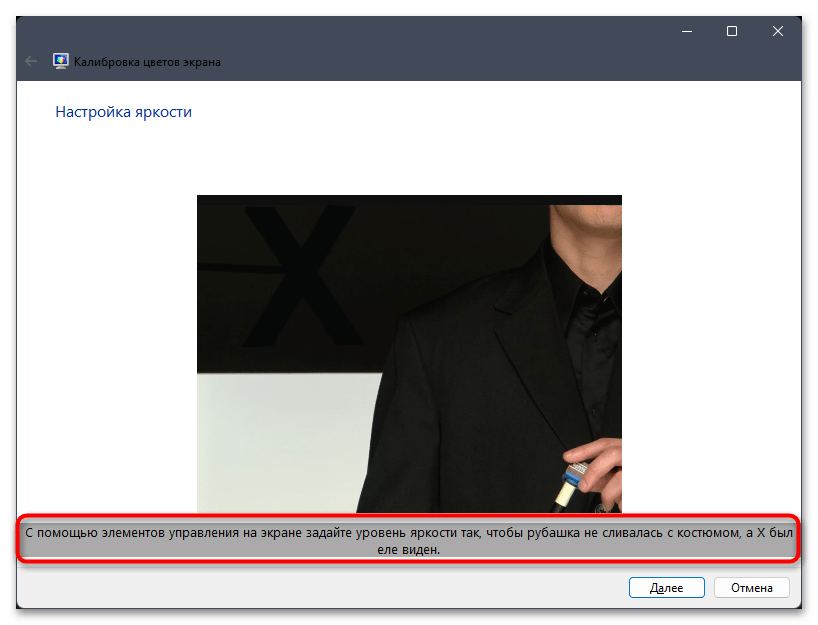




Способ 2: Стороннее программное обеспечение
Существует не так много программ, которые подходят для калибровки экрана монитора без использования дополнительной аппаратуры. Однако несколько подходящих вариантов все же есть, а в рамках этой статьи мы предлагаем остановиться на решении под названием QuickGamma. Эта бесплатная программа предназначена для быстрого регулирования гаммы на ПК и выбора основных цветов, что немного влияет на их баланс.
Скачать QuickGamma
- В главном экране слева вы видите текущее значение гаммы и уровень черного. При помощи кнопок на «Monitor Gamma» осуществляется регулировка сразу трех основных цветов. Это позволит вам понизить или повысить общую гамму. Как раз эта настройка и является основной в данной программе.
- Мониторы, работающие в режиме EDID RGB, тоже поддерживаются, поэтому в случае необходимости всегда можно переключиться на другой тип предпочтительных цветов.
- Помимо общих кнопок с настройками, QuickGamma поддерживает работу с каждым цветом отдельно. Для этого на верхней панели нажмите кнопку «Gamma», чтобы перейти к соответствующему меню.
- Управление в нем максимально простое и понятное: слева отображаются три основных цвета, а справа — регуляторы для каждого из них. Увеличивайте или уменьшайте гамму до тех пор, пока не достигнете желаемого результата.
- По завершении работы с QuickGamma в главном окне нажмите «OK» для сохранения настроек или «Cancel», чтобы сбросить их до состояния по умолчанию.

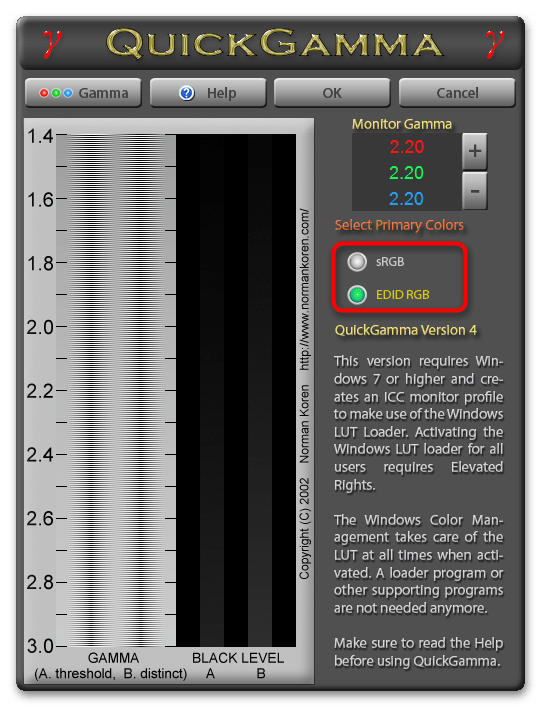


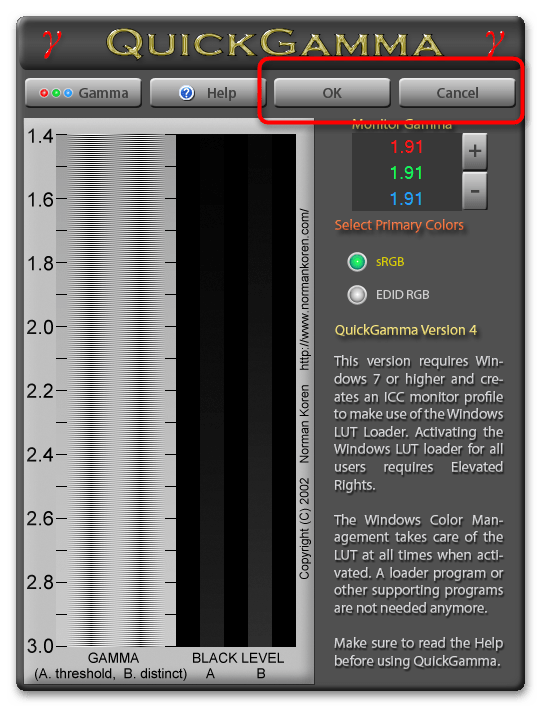
На нашем сайте есть отдельная статья с обзором всех программ, подходящих для калибровки монитора. Мы рекомендуем обратить внимание на нее, если приведенный выше пример показался не совсем актуальным для вашей модели монитора.
Подробнее: Программы для калибровки монитора
Способ 3: Меню управления монитором
Вкратце остановимся на методе, который подразумевает исключительно использование меню монитора с его настройками для калибровки. Если такое поддерживается, значит, на самом мониторе сбоку или снизу должны быть кнопки, при помощи которых открывается это меню и осуществляется переключение пунктов. Значение каждой кнопки очевидно, поскольку рядом всегда есть иконка, отображающая действие.
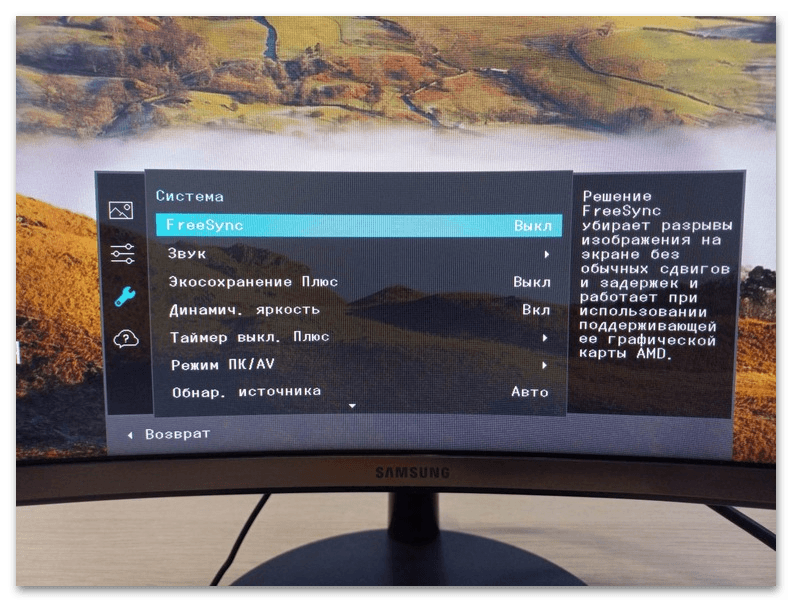
Предварительно можете открыть любое изображение для калибровки яркости, контраста, баланса цветов или гаммы, отыскав его в открытых источниках. Далее перемещайтесь по меню и находите нужные ползунки. Изменяйте их значения до тех пор, пока не добьетесь подходящего отображения. Кстати, для настройки яркости и контраста как раз можно использовать средства калибровки из Windows 11 с его примерами и инструкциями, о чем уже было рассказано выше.
Способ 4: Использование калибратора
Калибровка экрана монитора при помощи специальных аппаратных средств — дорогостоящая процедура, подходящая исключительно профессионалам. На картинке ниже вы видите пример того, как выглядит одна из моделей такого устройства. Обычно оно подключается к компьютеру по USB, далее крепится к монитору и считывает цвета.
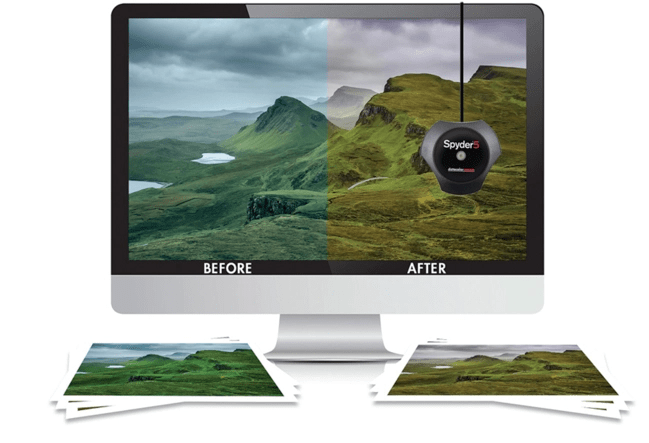
Сама калибровка происходит через фирменное программное обеспечение калибратора, соответственно, от каждого производителя оно будет разное. Мы не будем надолго останавливаться на данном методе, но примерно продемонстрируем, как выглядит взаимодействие с подобным ПО на примере DisplayCAL.
Скачать DisplayCAL с официального сайта
- Для работы с DisplayCAL вам понадобится приобрести калибратор от данного производителя и подключить его к компьютеру. Без устройства никакие настройки сохранены не будут. При запуске софта выберите дисплей для работы, если их подключено несколько.
- Далее прочитайте небольшую инструкцию от разработчиков о том, как происходит калибровка и что делать в случае появления различных неполадок или неточностей в считывании цветов.
- На панели сверху будет список «Настройки», из которого вы уже можете выбрать разные заготовленные параметры цветов для разных задач. Это подходит тем юзерам, кто уже знает, для каких целей используется монитор и какие значения передачи цветов нужно выставить.
- Если шаблон найден не был, происходит переход на вкладку «Калибровка», где уже осуществляется ручная настройка точки белого, уровня белого, кривой тональности и скорости калибровки. Дополнительные настройки будут на вкладке «Профилирование».
- Как только вы завершите настройку, понадобится щелкнуть по «Калибровка и характеризация», чтобы настройки вступили в силу. Иногда это может занять до часа времени.


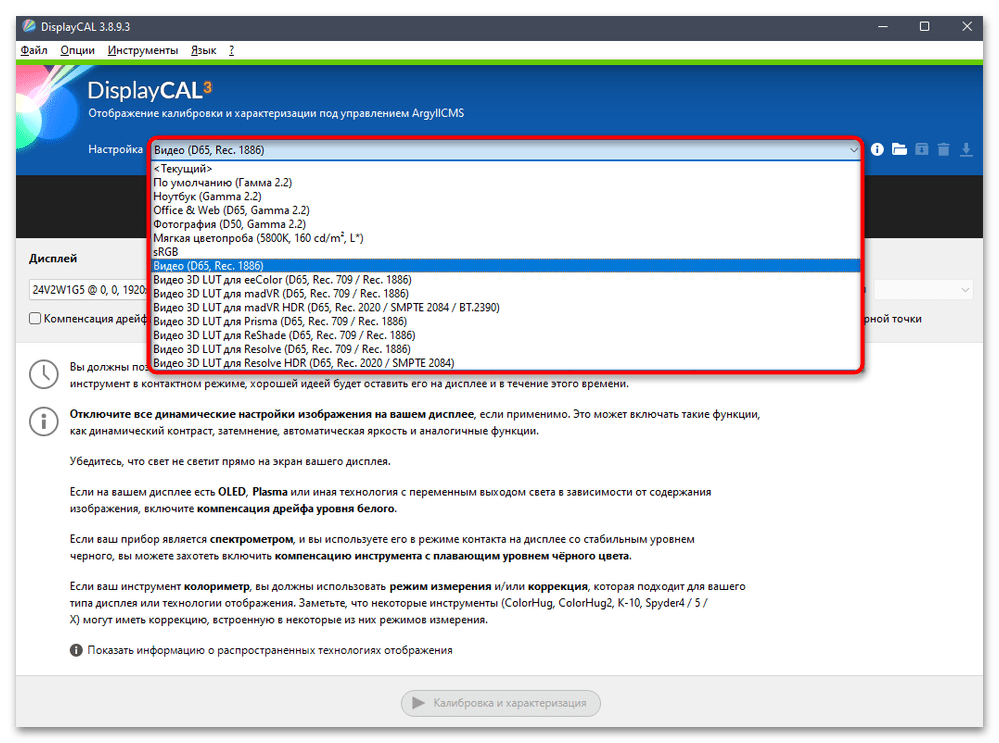
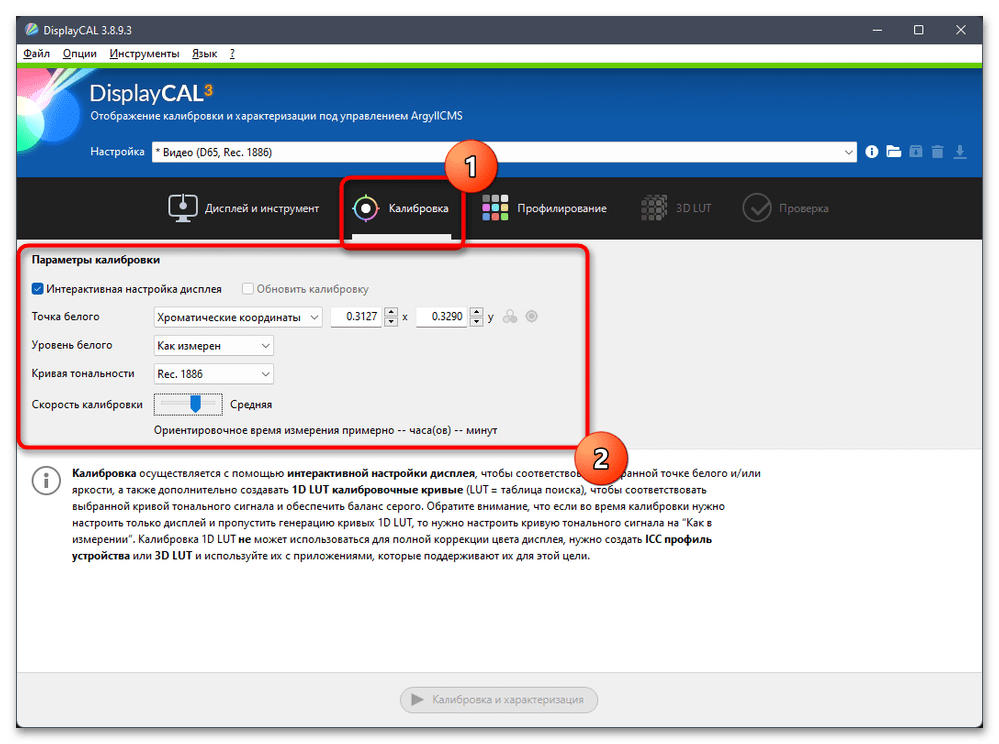

Это был только общий пример, демонстрирующий возможности подобного программного обеспечения. Работа с таким софтом напрямую зависит от приобретенного калибратора, поэтому обязательно читайте инструкции от производителей и еще перед покупкой ознакомьтесь с тем, для каких целей предназначен тот или иной калибратор.
Наша группа в TelegramПолезные советы и помощь
Changes in technology have impacted the way we shop. Thanks to advancements in e-commerce, you can now buy clothing, furniture, and your favorite trinkets online without having to make the trek over to a physical store. And by using the built-in color calibration feature in Windows 11, you can ensure that your online purchases look like what you ordered. Learn how to calibrate the colors on your screen before your next online shopping spree.
What is color calibration, and how does it work?
Color calibration, also known as display or monitor calibration, is the process of fixing your screen so it can show colors more accurately. If you ever order an article of clothing online and feel like the color doesn’t quite match what you saw on your screen, it’s likely an issue with how your monitor is calibrated. Photographers and designers also depend on properly calibrated displays so their pictures and designs appear the same on a printed copy. With a calibrated monitor, the colors on your display are consistently aligned with the actual product.
How to calibrate your colors in Windows 11
Calibrating your Windows 11 display is easy, and it can all be done within your device’s settings. Here are some steps on how to change your color settings:
1. Open your control panel
The quickest way to find the calibration tool is by searching for it in your Control Panel. You can access your Control Panel by searching control panel in Windows Settings or through Microsoft Support.
2. Navigate to color management
Once you have opened your Control Panel, search for color management in the search bar at the top of the window. Find the Color Management setting, then click on the Advanced tab to find options for display calibration.
3. Click on the calibrate display button
Select the Calibrate display button near the bottom of the window. You may need to enter your username and password before making any further changes to your device. After you enter your information, Windows will provide you with an explanation on how to change your display settings.
4. Read the instructions on how to adjust your screen
You will be able to click through several options for changing your color settings. Read through Windows instructions and adjust your gamma and brightness levels to what you feel is most accurate. A reference image will be provided for you as a guide. After you are satisfied with your changes, you can click on the Finish button to update your settings.
Calibrating your video quality
To take your color changes a step further, you can calibrate your video display through settings. Using color calibration for your video display can be helpful if you are viewing a video advertisement for the product you are contemplating on buying, or for improving the quality of your videos. Simply navigate to Settings > System > Display > HDR > Display calibration for HDR video > Calibrate to find options for changing your video quality.
By adjusting your display calibration in Windows 11, you can minimize the risk of getting an inaccurate color when you shop online. Upgrade to Windows 11 to get the most up-to-date Windows tools and online shopping features.
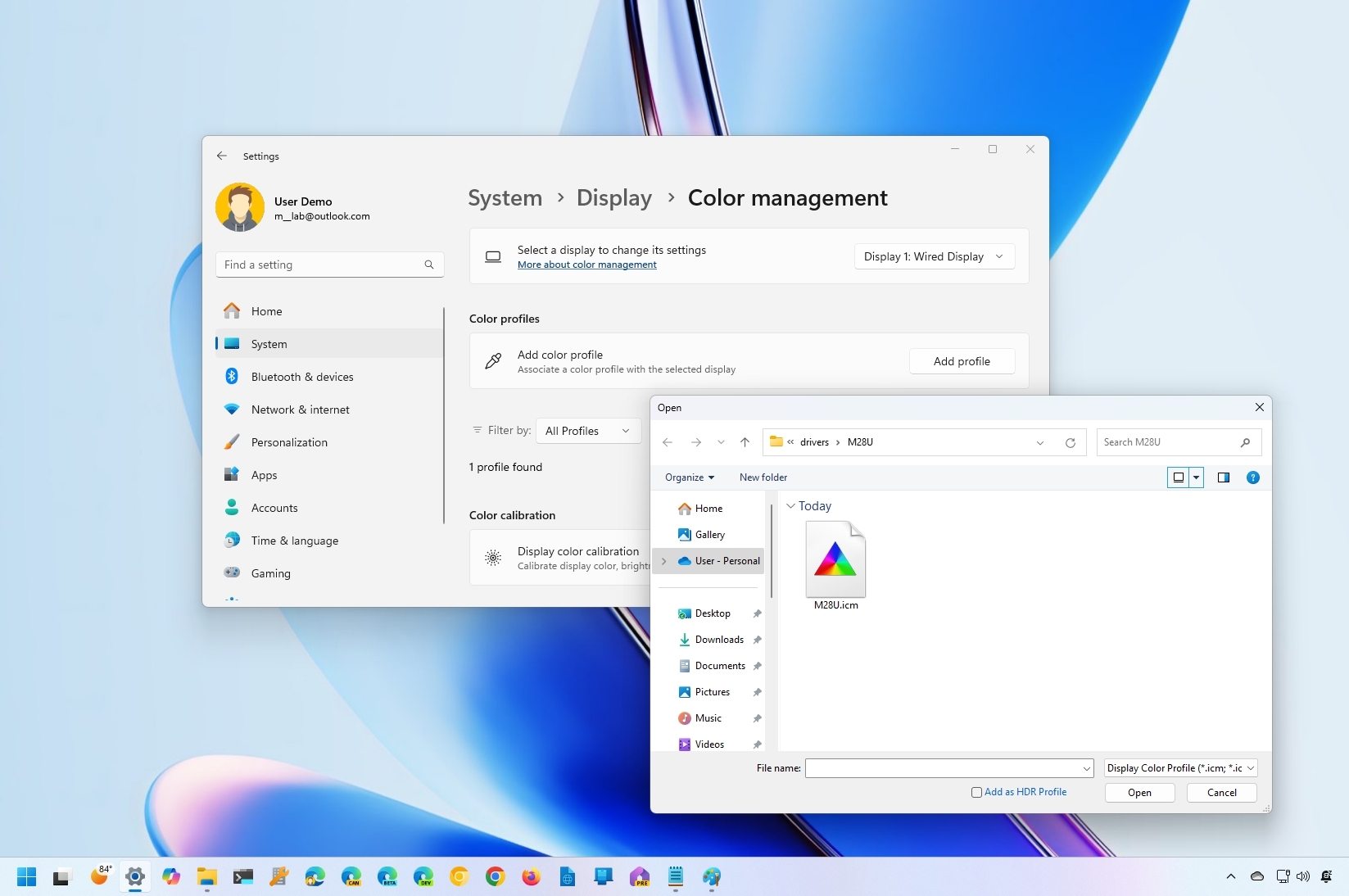
(Image credit: Mauro Huculak)
On Windows 11, similar to any operating system, accurate color rendering on the screen is critical, even more for those professionals working on video editing, photography, or gamers. As a result, in this guide, you will learn the steps to set the correct color profile for your monitor.
A color profile is a combination of settings that manufacturers create to describe how colors should be rendered on the display. Only after setting the correct profile will you be able to experience the intended color representation.
Although the operating system can detect and configure the appropriate profile if you notice that the colors don’t look accurate, the problem is probably not the monitor but rather the profile, which you can update from the Color Management application available on Windows 11.
In this how-to guide, I will walk you through the steps to use the correct color profile on Windows 11 version 24H2, 23H2, and older releases.
How to download color profiles for a display on Windows 11
Usually, the color profiles («ICM» or «ICC» files) available for your monitor come in the driver package or the installation disc. However, you can always download the files from the manufacturer’s website.
To find and download the correct color profile on Windows 11, use these steps:
- Open the monitor’s support page.
- Quick note: Some of the popular manufacturer’s sites include LG, BenQ, Samsung, Dell, and HP.
- Browse to the download section.
- Search for the latest monitor driver (not the graphics driver) using the model number of your device.
- Quick tip: You can find the monitor model number on the back of the device or, on Windows 11, open Settings > Displays > Advanced display.
- Click the Download button and save the file on your computer.
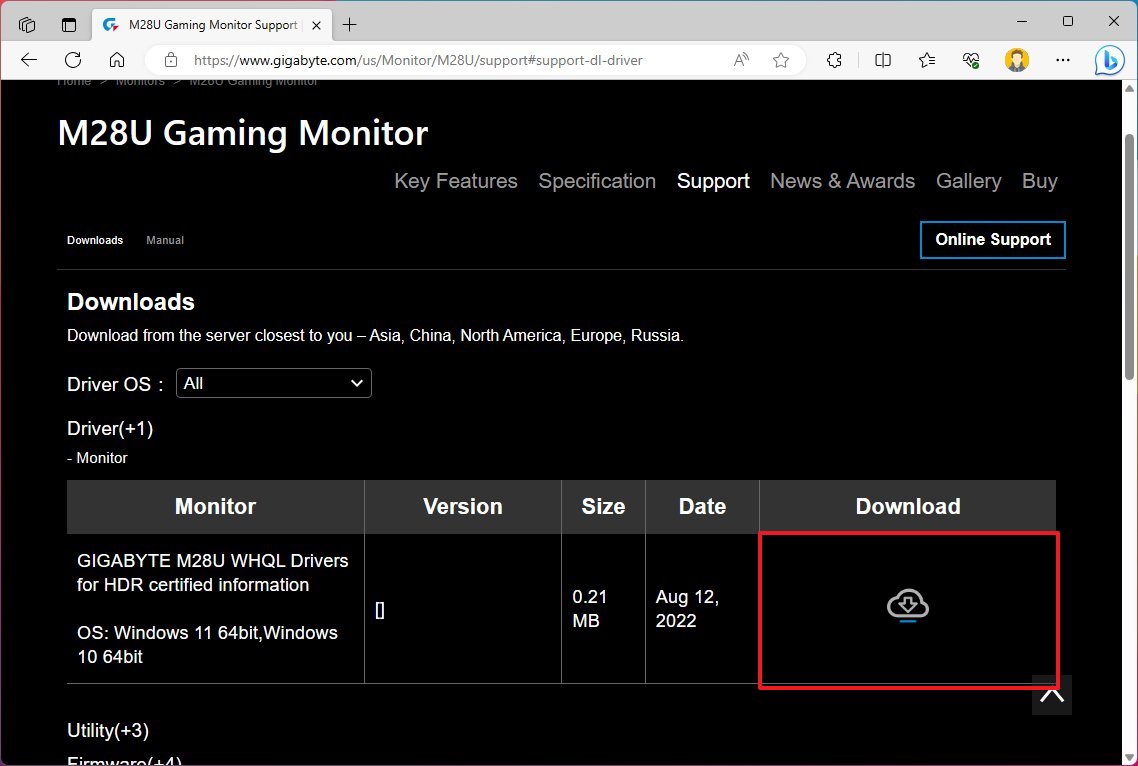
- Double-click to open the file.
- Click the Extract all button from the command bar (if this is a Zipped folder).
- Continue with the on-screen directions to extract its content.
- Open the folder with the extracted files.
- Confirm the «.icm» file, which is the color profile for your monitor.
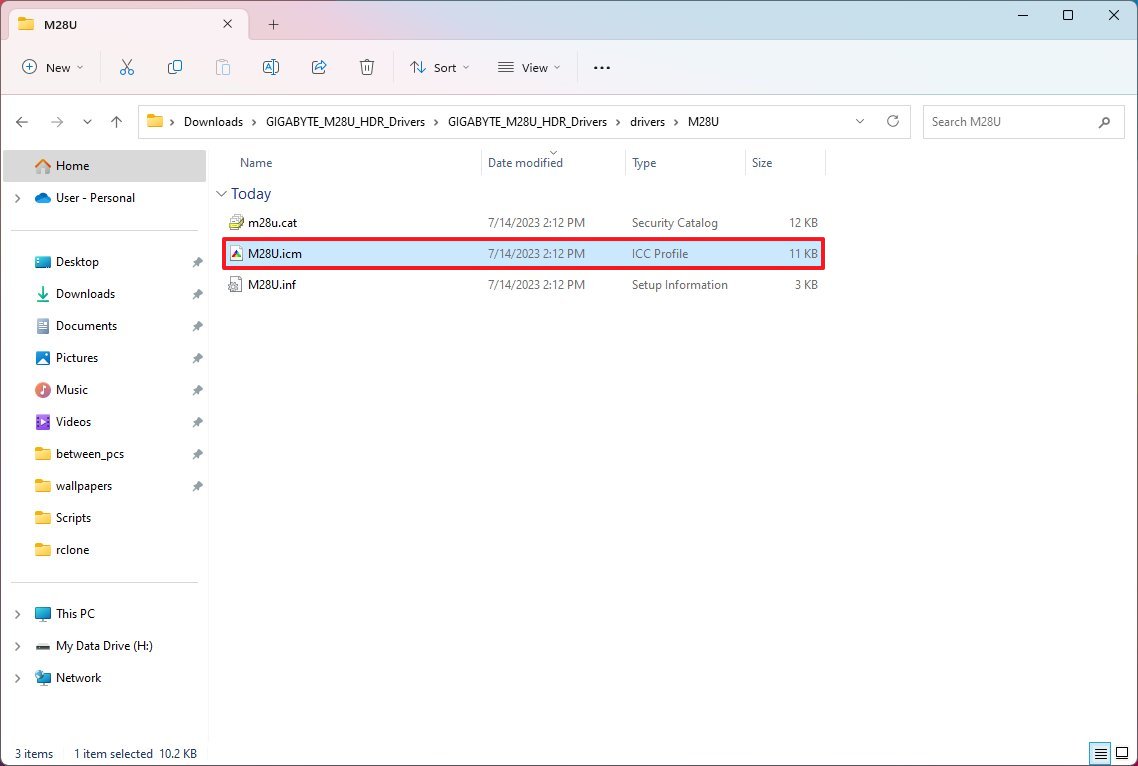
Once you complete the steps, you can install the appropriate color profile for the computer’s monitor on Windows 11.
All the latest news, reviews, and guides for Windows and Xbox diehards.
How to install color profiles for a display on Windows 11
On Windows 11, you can install and manage color profiles from the «Color Management» tool or from the Settings app starting with version 24H2 and higher releases.
Steps for Windows 11 2023 Update
To install a color profile on Windows 11 (version 23H2 and older releases) from the legacy Color Management settings, use these steps:
- Open Settings.
- Click on Display.
- Under the «Related settings» section, click the Advanced display setting.
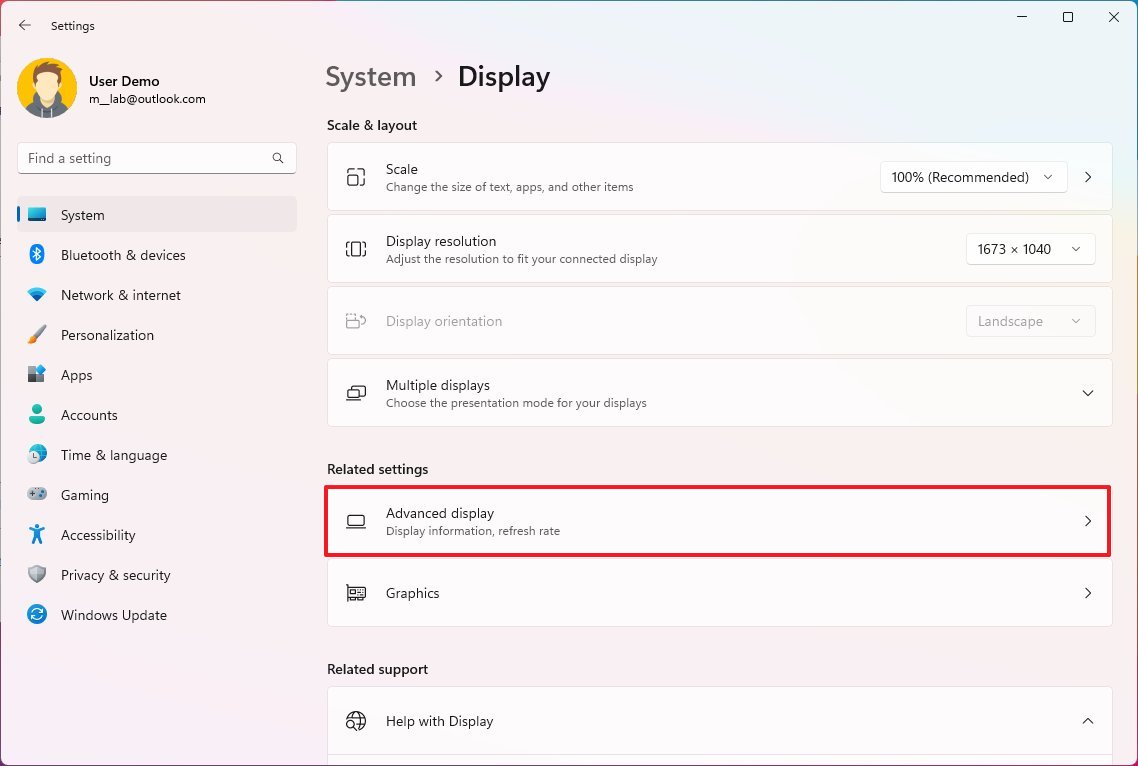
- Under the display settings, click the «Display adapter properties for» settings to graphics adapter properties.
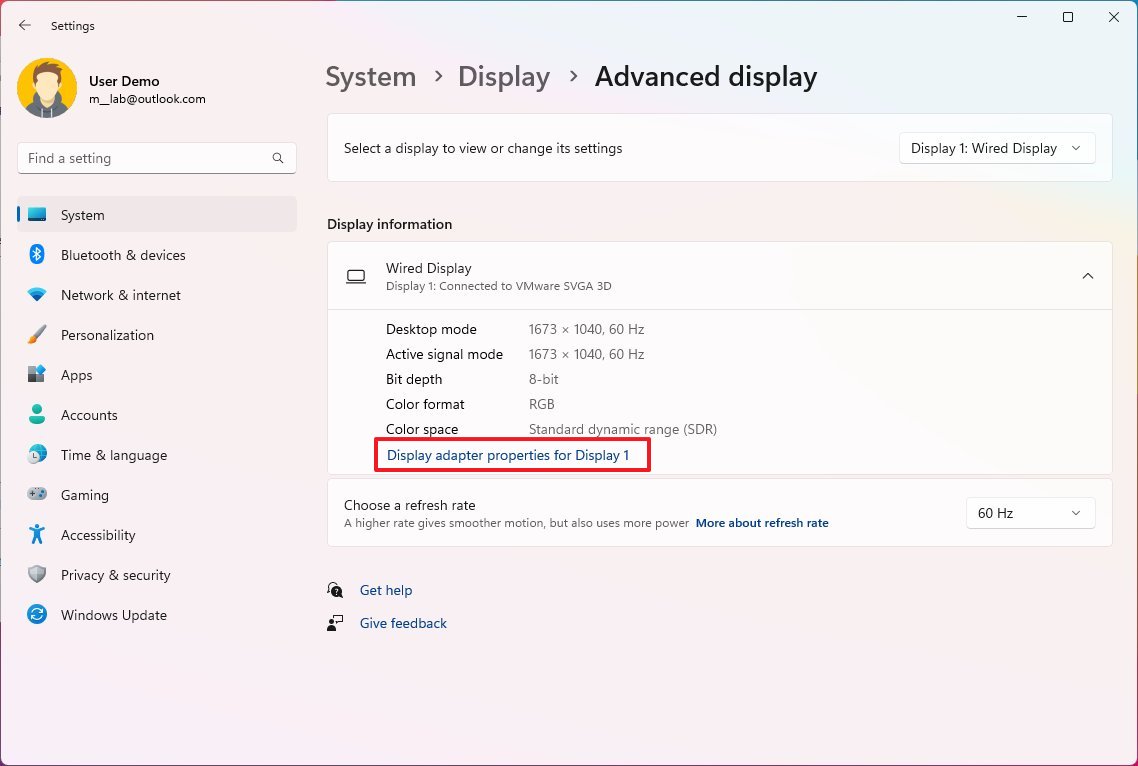
- Click the Color Management tab.
- Click the Color Management button.
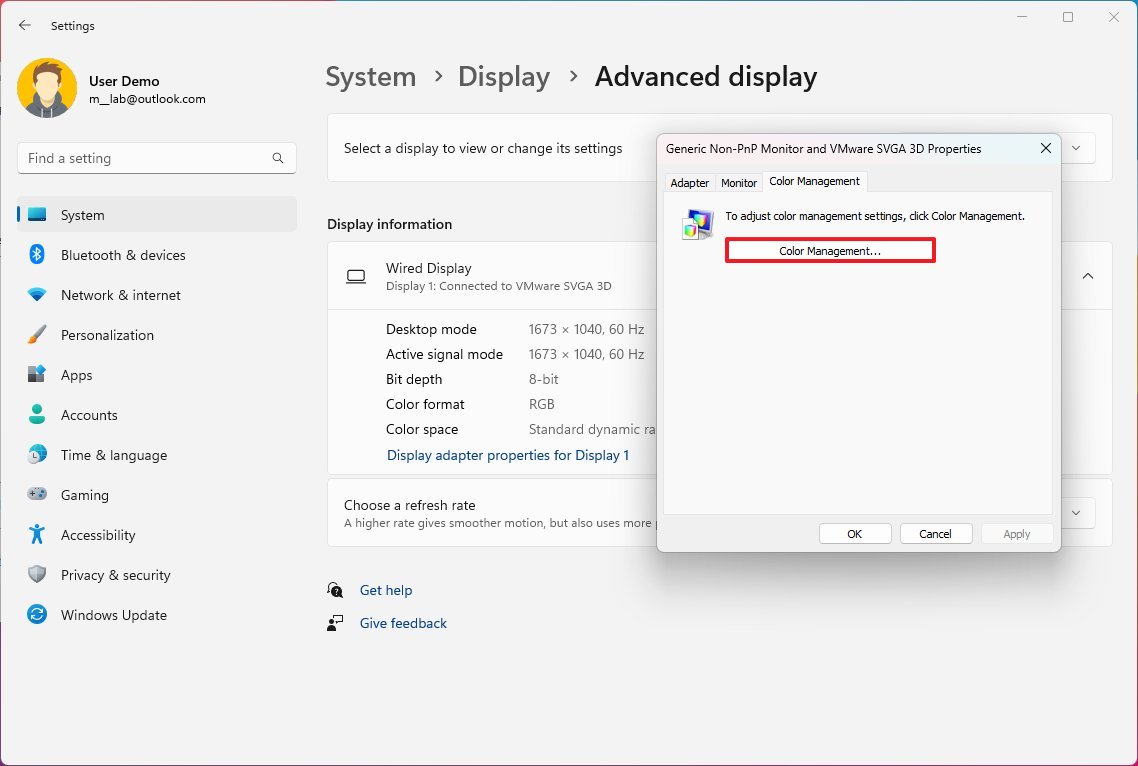
- Click the Devices tab.
- Choose the monitor to apply a new color profile using the «Device» setting.
- Quick tip: If you have a multi-monitor setup and you’re not sure which monitor you’re about to update, click the «Identify monitors» button.
- Check the «Use my settings for this device» option.
- Click the Add button.
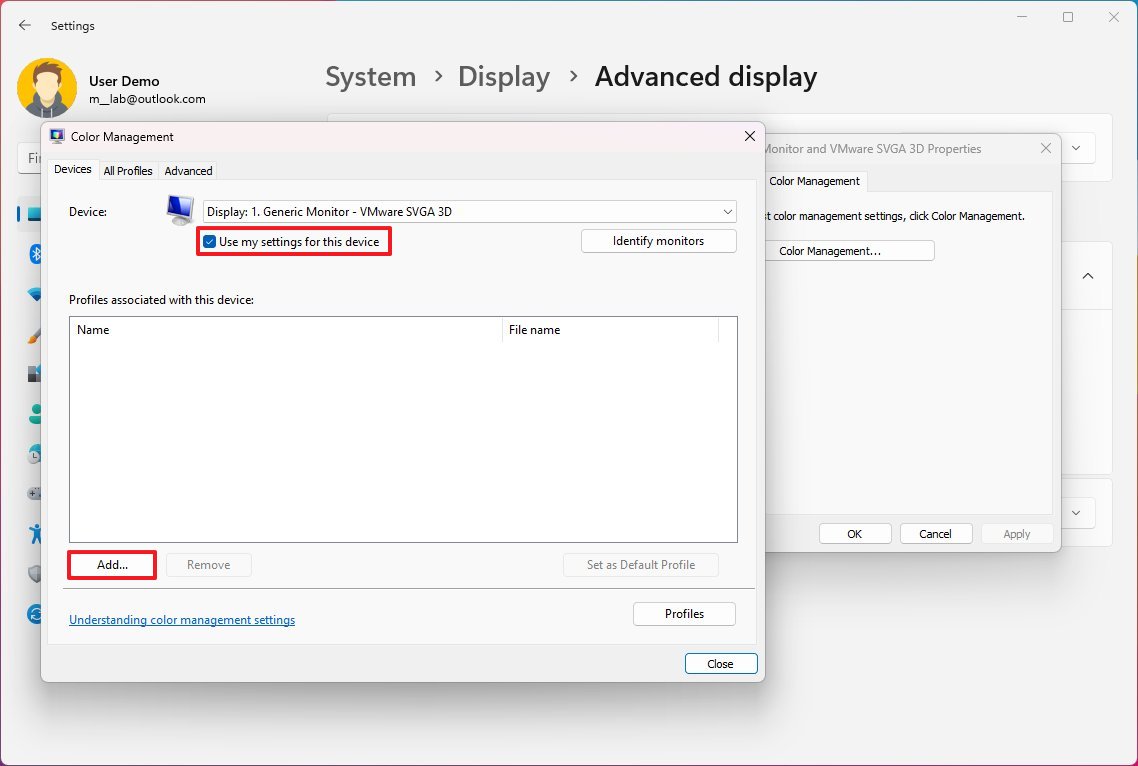
- In the «Associated Color Profile» page, click the Browse button.
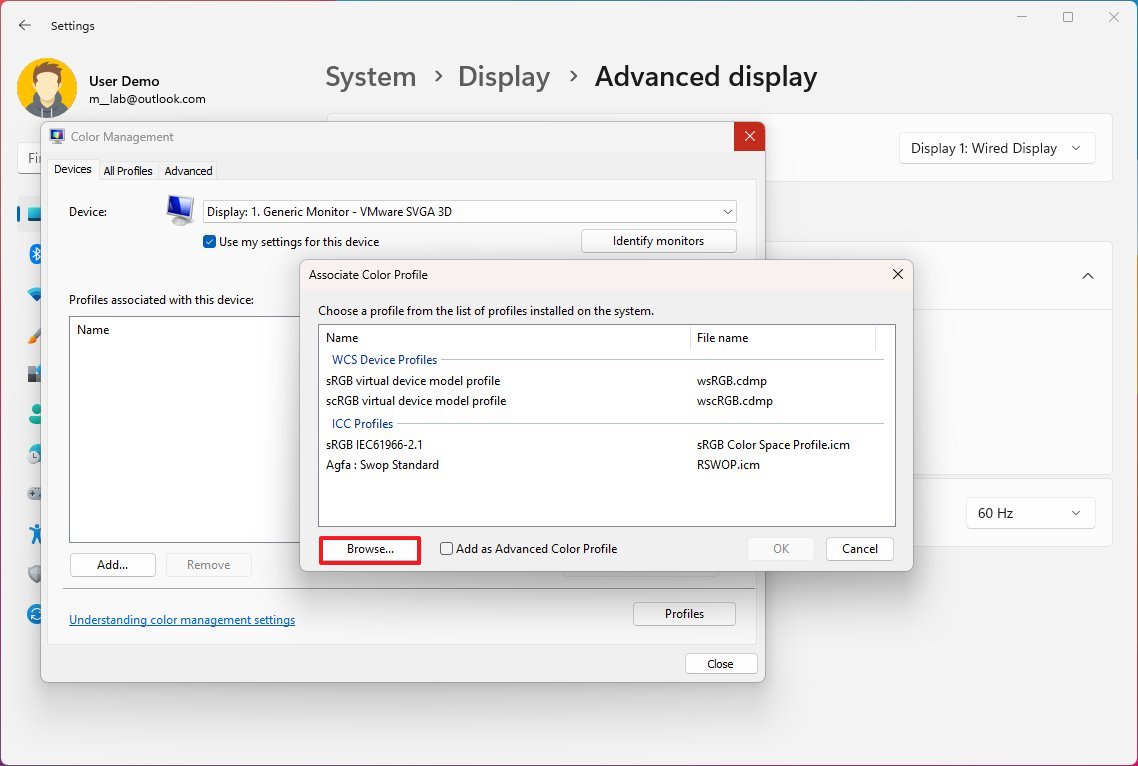
- Open the folder with the color profile file.
- Select the «.icm» file.
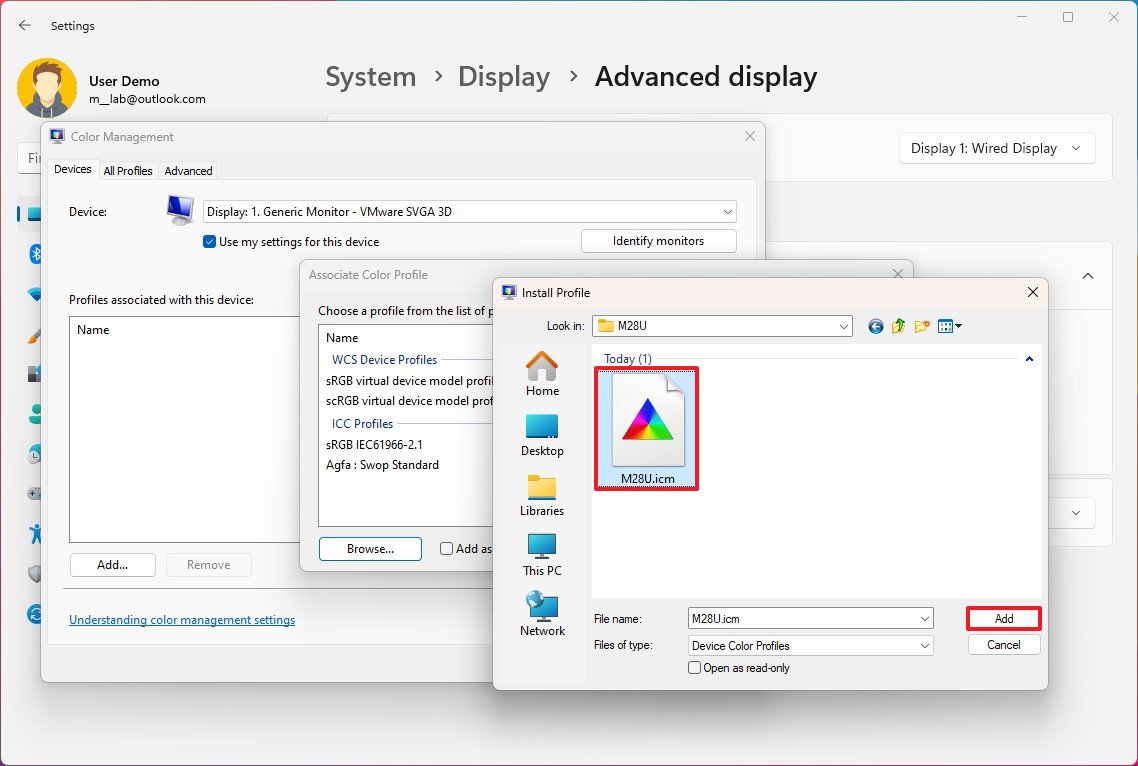
- Click the Add button.
- Click the Close button.
After you complete the steps, the profile will apply, and you should now be able to notice a change in how the display renders colors.
If you want to remove the specific profile, follow the same instructions, but in step 9, select the profile from the list and click the «Remove» button. However, the file containing the profile instructions will continue to be available on your computer. You can refer to the reset instructions to remove it.
Steps for Windows 11 2024 Update
To install a color profile on Windows 11 (version 24H2 and higher releases) from the modern Color Management settings, use these steps:
- Open Settings.
- Click on System.
- Click the Display page on the right side.
- Click the Color profile setting under the «Brightness & color» section.
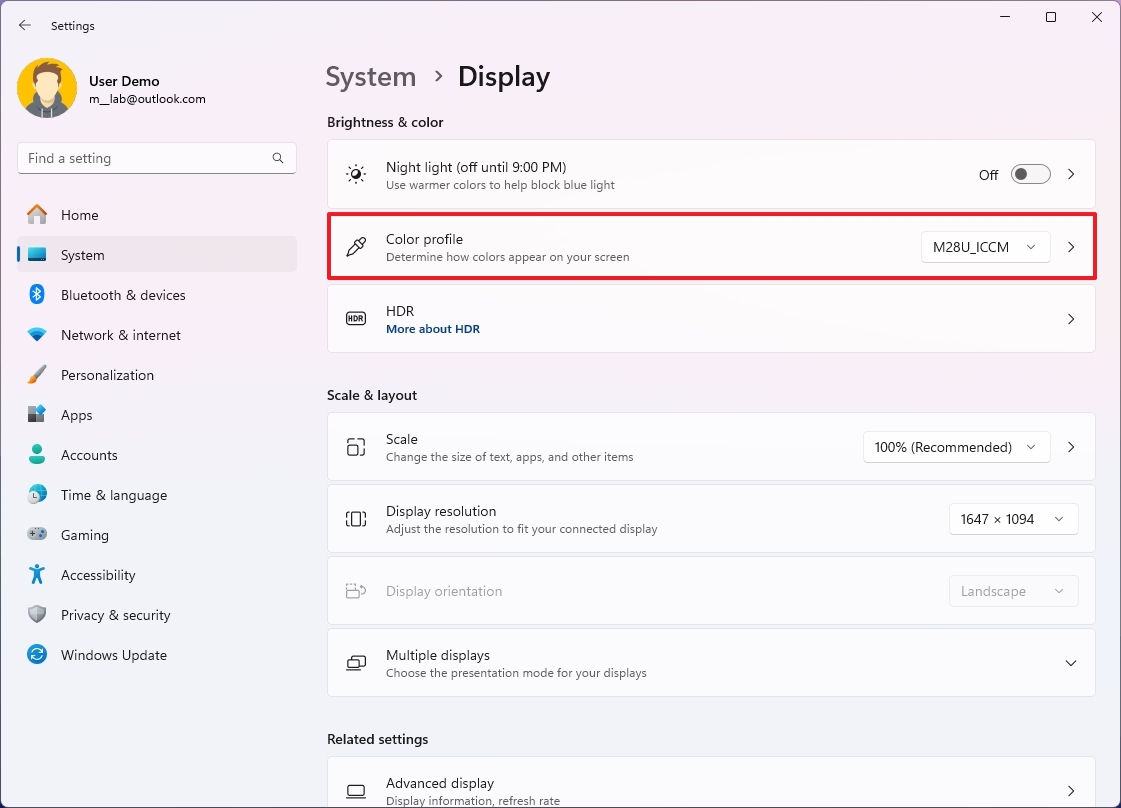
- Click the Add profile button in the «Add color profile» setting.
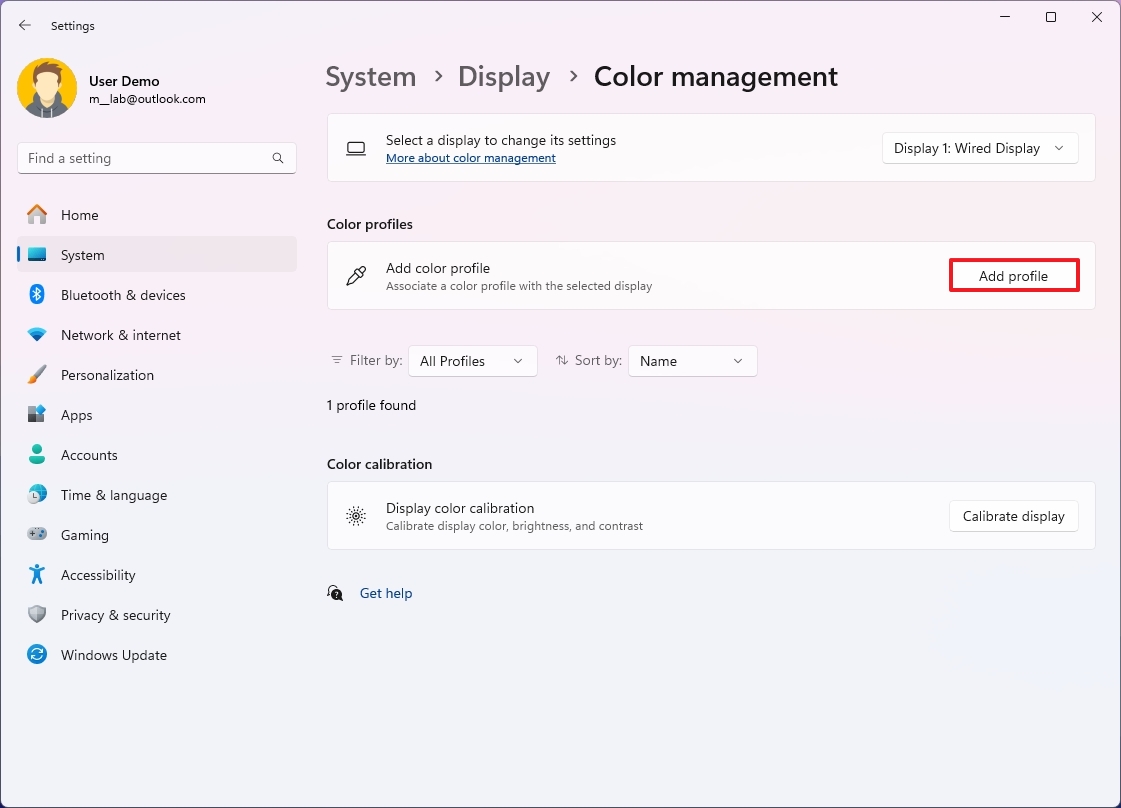
- Choose the profile file with the «icm» or «icc» extension.
- Click the Open button.
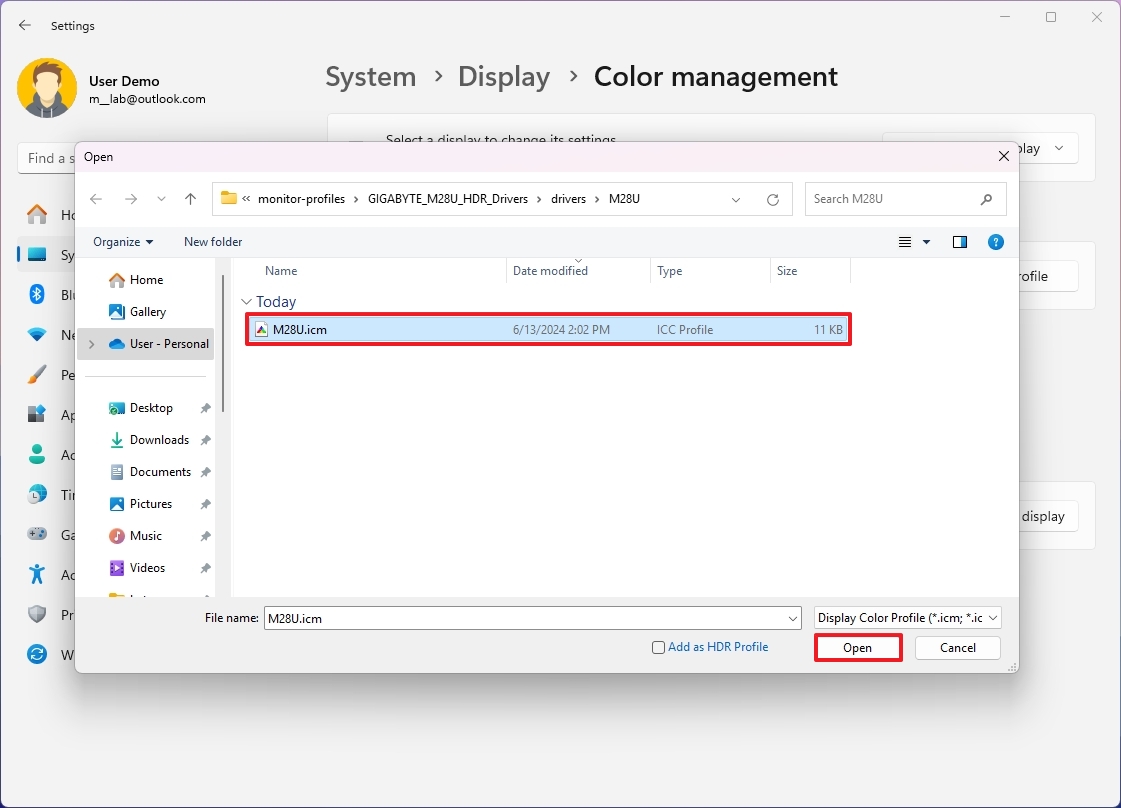
- (Optional) Click the profile setting to review the different details like color space, version, file name, and more.
- (Optional) Click the Set profile button if you have multiple profiles.
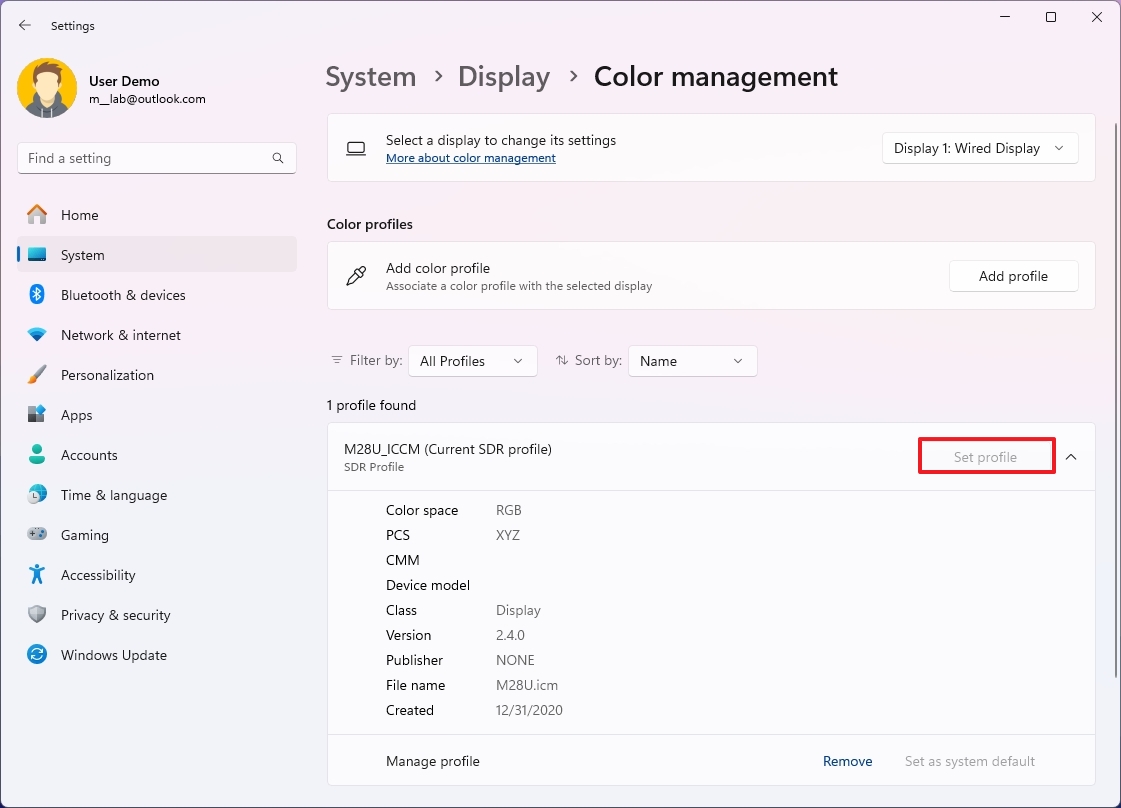
Once you complete the steps, the new profile will be applied to your computer.
If you want to remove the specific profile, follow the same instructions, but in step 9, click the «Remove» button. However, the file containing the profile instructions will continue to be available on your computer. You can refer to the reset instructions to remove it.
How to reset color profile settings on Windows 11
In the case that you need to roll back the previous settings, you can use the instructions below to reset to the default color profile configuration on Windows 11 version 24H2, 23H2, and older releases.
To reset the color profile to the default settings, use these steps:
- Open Start.
- Search for Color Management and click the top result to open the app.
- Click the Devices tab.
- Click the Profile button.
- Select the monitor to reset using the «Device» setting.
- Click the Profiles button and choose the «Reset my settings to the system defaults» option.
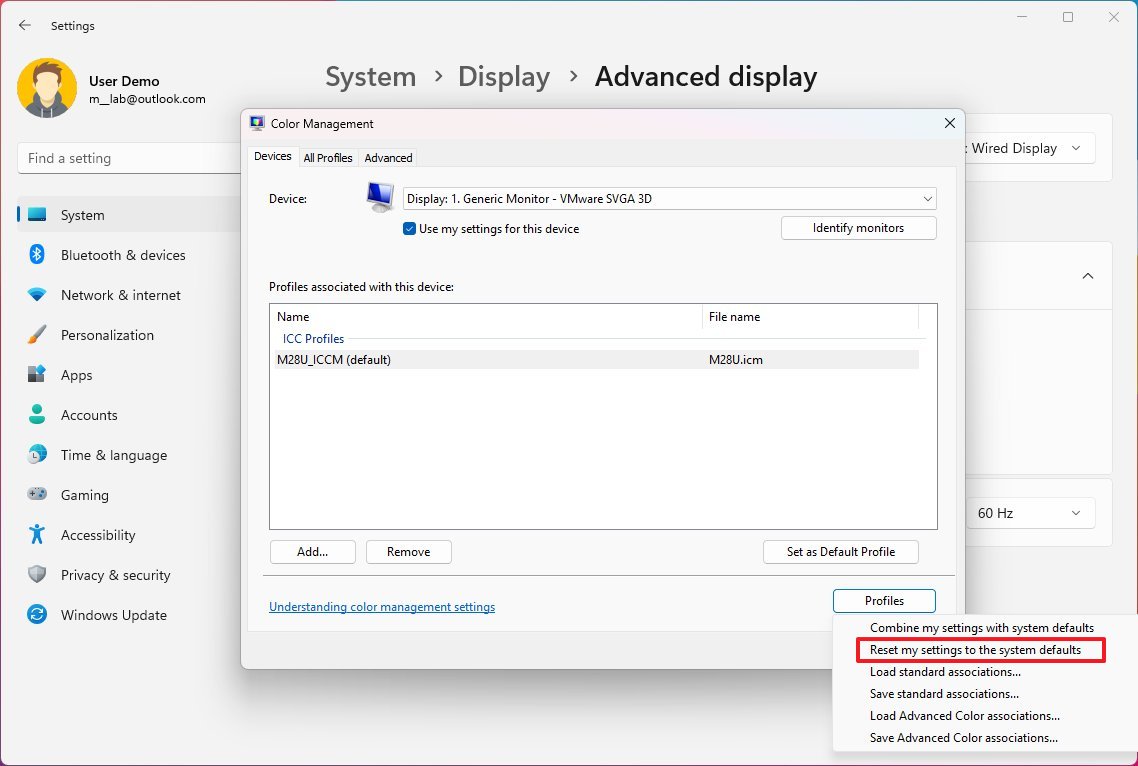
- (Optional) Click the All profiles tab.
- Select the profile you want to remove.
- Click the Remove button.
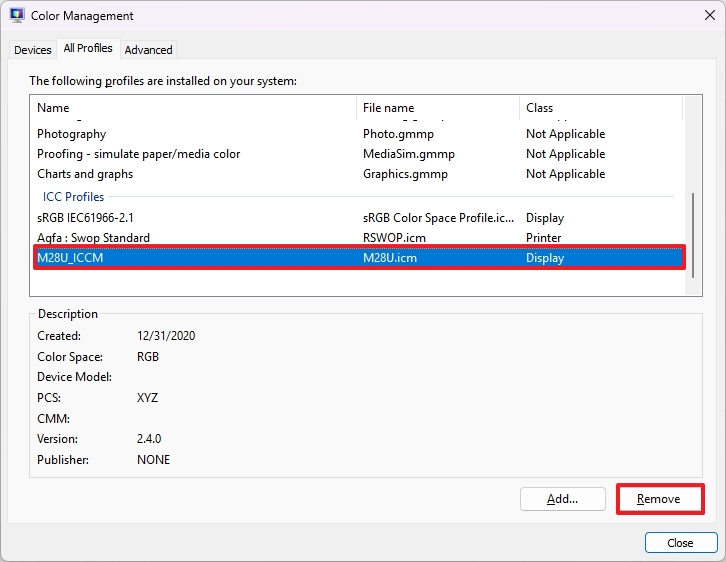
Once you complete the steps, the profile settings will roll back to the original configuration for that specific monitor.
It’s important to note that even though you can configure a custom profile for your monitor manually, typically, when you connect a display to the computer, the system sets up the recommended color profile. As a result, you should only consider using these instructions if the device is using the wrong profile or you have specific requirements to change the color profile on Windows 11.
More resources
For more helpful articles, coverage, and answers to common questions about Windows 10 and Windows 11, visit the following resources:
- Windows 11 on Windows Central — All you need to know
- Windows 10 on Windows Central — All you need to know
Mauro Huculak has been a Windows How-To Expert contributor for WindowsCentral.com for nearly a decade and has over 15 years of experience writing comprehensive guides. He also has an IT background and has achieved different professional certifications from Microsoft, Cisco, VMware, and CompTIA. He has been recognized as a Microsoft MVP for many years.
Calibrating your monitor in Windows 11 is a straightforward process that ensures your screen displays colors accurately. By following a few simple steps, you can adjust the settings to achieve the best visual experience. This involves using built-in tools to fine-tune your display’s brightness, contrast, and color levels. Let’s dive into the step-by-step process!
Calibrating your monitor in Windows 11 will adjust your display settings to produce accurate colors and optimal screen quality. This process involves several steps using the built-in Display Color Calibration tool. Here’s how to do it:
Step 1: Open Display Settings
First, right-click on your desktop and select “Display settings” from the context menu.
This will open the Display settings window where you can adjust your screen resolution, orientation, and other display preferences.
Step 2: Launch Display Color Calibration
Next, scroll down and click on “Advanced display settings,” then select “Color calibration.”
The Display Color Calibration tool will open, guiding you through the process of adjusting your monitor’s colors.
Step 3: Follow the On-Screen Instructions
Click “Next” to begin the calibration process and follow the on-screen instructions.
The tool will prompt you to adjust various settings, such as gamma, brightness, contrast, and color balance. Pay attention to each step to ensure accurate calibration.
Step 4: Adjust Gamma Settings
Adjust the gamma settings using the slider until the dots in the example image are barely visible.
Proper gamma settings ensure that your monitor displays the correct range of light and dark shades.
Step 5: Adjust Brightness and Contrast
Next, use the on-screen images to adjust your monitor’s brightness and contrast settings.
These adjustments help to balance the light and dark areas on your screen, enhancing the overall picture quality.
Step 6: Adjust Color Balance
Finally, adjust the color balance by tweaking the red, green, and blue sliders until the grayscale image looks neutral.
Correcting the color balance ensures that your monitor displays colors accurately, without any color cast.
Step 7: Save and Finish
Once you’re satisfied with the adjustments, click “Finish” to save your new display settings.
Your monitor will now use the calibrated settings, providing more accurate and pleasing visuals.
After you complete the calibration process, your monitor will display colors more accurately and consistently. This is particularly important for tasks that require color precision, such as photo editing or graphic design.
Tips for Calibrating Monitor in Windows 11
- Make sure to calibrate your monitor in a neutral lighting environment to avoid color casts.
- Give your monitor at least 30 minutes to warm up before starting the calibration process.
- Use a calibration tool or hardware device for more precise adjustments.
- Repeat the calibration process periodically to maintain accurate display settings.
- Compare before and after images to ensure your adjustments are effective.
Frequently Asked Questions
What is monitor calibration?
Monitor calibration is the process of adjusting the display settings to ensure accurate color representation and optimal visual quality.
Do I need special tools to calibrate my monitor?
No, Windows 11 includes a built-in Display Color Calibration tool. However, hardware calibration devices can provide more precise adjustments.
How often should I calibrate my monitor?
It’s recommended to recalibrate your monitor every few months or whenever you notice color inaccuracies.
Can I use the same calibration settings for multiple monitors?
No, each monitor may have different characteristics, so it’s best to calibrate each one individually.
What is gamma adjustment?
Gamma adjustment fine-tunes the brightness levels of your monitor to ensure a balanced display of dark and light shades.
Summary
- Right-click on desktop and select “Display settings.”
- Scroll down and click “Advanced display settings,” then “Color calibration.”
- Follow the on-screen instructions.
- Adjust gamma settings.
- Adjust brightness and contrast.
- Adjust color balance.
- Save and finish.
Conclusion
Calibrating your monitor in Windows 11 is essential for anyone who relies on accurate color representation. Whether you’re a graphic designer, photographer, or just someone who enjoys a high-quality visual experience, taking the time to adjust your display settings can make a big difference. By following the steps outlined above, you can ensure that your monitor displays colors as they should be, providing a more enjoyable and accurate viewing experience.
Remember, the environment in which you calibrate your monitor plays a crucial role in achieving the best results. Make sure your room lighting is consistent and neutral. Also, give your monitor some time to warm up before you start the calibration process.
For those looking for more precise adjustments, investing in a hardware calibration tool can be beneficial. These devices can provide more accurate measurements and adjustments than the built-in software tools. However, the built-in Display Color Calibration tool in Windows 11 is a great starting point and can significantly improve your monitor’s display quality.
Now that you know how to calibrate your monitor in Windows 11, why not give it a try? Your screen—and your eyes—will thank you!
Matthew Burleigh has been writing tech tutorials since 2008. His writing has appeared on dozens of different websites and been read over 50 million times.
After receiving his Bachelor’s and Master’s degrees in Computer Science he spent several years working in IT management for small businesses. However, he now works full time writing content online and creating websites.
His main writing topics include iPhones, Microsoft Office, Google Apps, Android, and Photoshop, but he has also written about many other tech topics as well.
Read his full bio here.
Not many Windows users may be familiar with the concept, but calibrating your screen colors may just improve your experience on the computer.
It may be possible that you have just added a new screen to your PC, or that your old display device has lost its novelty and the colors have kind of faded away. In such cases, you may want to recalibrate your screen often.
If you work with videos and images or play games on your PC, calibrating your monitor would assist you to achieve more natural colors. Not only that, but the colors of the images on your device may be nearly the same as on other devices if you are sharing.
Table of Contents
If all display devices were calibrated the same way, the colors of every item would appear to be the same on each display device. Sadly, each display monitor manufacturer has its own calibration configuration, bringing nonlinearity to the colors across different devices.
Thankfully, Windows 11 includes a free display calibration tool that helps you adjust your gamma, brightness, contrast, and color balance. The preinstalled Display Color Calibration tool allows you to adjust some settings through the tool, while some need to be adjusted through the menu on the display device itself.
Before we begin calibrating our display(s), let us show you 4 ways you can access the Display Color Calibration tool in Windows 11.
How to Open Display Color Calibration in Windows 11
Through Run
You can open the Display Color Calibration tool by typing in a small cmdlet in Run, which will open the tool for you. Type in dccw in Run and hit Enter to launch the tool.
By Search
Another quick way to launch the tool is by searching from it through the Windows Search box. Search for “Calibrate” in the Search box. When Calibrate display color is highlighted, hit Enter on the keyboard.

Through the Control Panel
The calibration tool can also be accessed through the Control Panel. Here is how:
- Open up the Control Panel by typing in control in Run.
- Now select View by to Small icons, and then click Color Management.
- From the Color Management window, switch to the Advanced tab, and then click Calibrate display.
The Display Color Calibration tool will now be launched.
Through Settings App
The tool can also be accessed through the Settings app. Here is how:
- Navigate to the following:
Settings app >> System >> Display >> Advanced Display - Now click Display adapter properties for… under the Display information section.
- From the Properties window, switch to the Color Management tab, and then click Color Management.
- From the Color Management window, switch to the Advanced tab, and then click Calibrate display.
Now that you know how to access the tool, let us now continue to learn how to use it.
How to Calibrate Monitor Display Color in Windows 11
As we mentioned earlier, it is important to calibrate your display colors so that if you share your work with someone, they may see the same colors that you see on yours. It is not necessary that what may seem vibrant on your display device will seem the same way on another device.
Some users believe that calibration may only be needed once the display device is being set up for the first time. However, that is not entirely true. Yes, you should calibrate your monitor when it is being used for the first time. However, the best practice is to recalibrate it every 6 months.
This is because the display devices can lose their color sharpness, changing the output results from the actual colors. Here is how you can (re)calibrate your display device(s) easily (for free) using the built-in Display Color Calibration tool in Windows 11:
- Open the Display Color Calibration tool using any of the methods above.
- The tool will now launch where you can see instructions on each page guiding you on what to do. If multiple displays are connected, drag the tool window onto the screen that you want to calibrate, then click Next.
- You will then be asked to restore your display’s color settings to the default values through its own menu, which can be accessed directly through the button on the display device. What you can do is perform a factory reset to bring it back to the default value. Once done, click Next on the tool.
- The next page tells you what the perfect gamma settings should look like. Gamma is a mathematical combination of the colors red, green, and blue, that ultimately defines the amount of light emitted from your display device. Notice how the gamma images are different from each other. On the next screen, we must achieve the gamma settings manually to match the image in the center (Good gamma). Therefore, take a good, hard look at the center image and then click Next to begin the calibration process.
- On the next screen, adjust the slider on the left so that the small dots in the center of the circles are barely visible. If you think that the gamma settings are ideal to match the center image on the previous screen, click Next.
- You will be asked to adjust the brightness and contrast of your display. These settings are controlled directly through your display device. Therefore, click Next if your device has these settings, otherwise click Skip brightness and contrast adjustment.
- If you click Next in the last step, you will now see a guide to adjust your screen’s brightness to an optimized settings. Notice how the “Good Brightness” image looks. This is what you shall be trying to achieve on the next screen while calibrating your display’s brightness. Click Next to begin.
- On the next screen, you will see an image that will assist you in obtaining an optimized brightness level. Adjust your display device brightness level until you can distinguish the black shirt from the black coat, and then “X” is barely visible. Click Next when done.
- Next you shall adjust the display contrast using the center image. Notice how the wrinkles on the shirt are creating a shadow effect. This is what you will be using to achieve a good contrast. Click Next to begin.
- Now adjust your display device’s contract using its menu. The goal is to set the contrast as high as possible while still being able to see the wrinkles and the buttons on the shirt prominently. Once done, click Next.
- The next phase involves balancing out the red, blue, and green colors on the display device. This will be done using the Display Color Calibration tool, you may now close the display device’s menu. Notice how different combinations of excessive colors change the shade. We must try to achieve neutral grey colors on the next screen by adjusting the sliders for each color. Click Next to begin.
- On the next screen, scale up and down the slider beneath each color to achieve neutral grey shades and try different combinations. Once you are happy with the results, click Next.
- On the next screen, you can compare your previous calibration with the current one (with the new settings) and see the changes. Once you are sure you want to keep the new display color calibration, uncheck the box next to “Start ClearType Tuner when I click Finish to ensure that text appears correctly” and then click Finish.
Closing words
The Display Color Calibration tool has been around for some time now. If you are using Windows 10, you can also use this tool to calibrate your display settings there as well.
Another useful calibration tool in Windows is the ClearType Tuner. This tool helps you calibrate the text by adjusting its font, thickness, height, sharpness, etc. Not only that, you can use this tool for text calibration of each display monitor.
If you have the time, you can access the ClearType Tuner tool by keeping the box checked in step 13 above, or by searching for it through the Search box.















